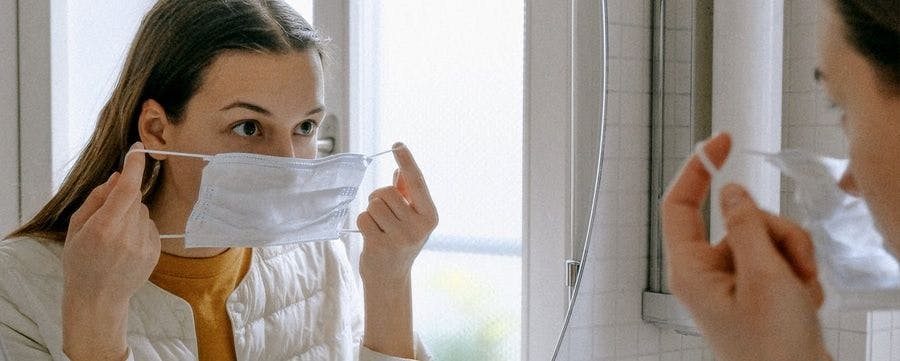Can Wearing A Mask After Having Injectables Pose Problems?

The pandemic has yielded copious opportunities for new patient queries, particularly in connection to current face covering requirements. One question aesthetics practitioners are being asked is, “can wearing a mask after having injectables pose problems?”
Our general societal responsibility to wear a mask in public is so crucial right now. But, is there anything patients should be concerned about with regard to face coverings? Harley Academy’s director of education, Dr Kalpna Pindolia advises that the risk of mask-induced adverse events are likely minimal if masks are clean and well-fitting.
With upper face injectable treatments, mask wearing is irrelevant. However, where mid-face, lower-face treatments or skin barrier compromising treatments such as microneedling and chemical peels are involved, there are a few scenarios practitioners should be aware of.

Ensure your patient has a clean, disposable mask for after their treatment
Providing your patient with a fresh disposable, fluid-resistant surgical mask (Type IIR) upon discharge is a wise move. Apart from the expression of added care, this will ensure the injected area is kept clean when they leave the clinic, will stop them touching their face and minimises the risk of infection from putting a used mask back on post-treatment.
Masks should be changed if they become wet or damaged. Responsible disposal of the mask is important too, especially if it has blood on. Advise against reusing it and to replace it if it gets damp. Snipping the ear loops before putting the mask in the bin avoids wildlife becoming trapped in them.
If a patient insists on wearing their own mask, it must be clean and well-fitting
A used and potentially dirty mask will increase their risk of infection. If the patient insists on wearing their own mask, it may be worthwhile suggesting a compromise of them wearing a clean, dry, disposable surgical mask underneath their own mask.
Face masks should not be kept on for too long after injectables
When wearing a face covering for a significant period of time, the combination of heat and moisture trapping creates the ideal environment for bacterial replication. Respiratory secretions generated through breathing, coughing and talking combine with skin flora, sebum, oil and debris to cause a potential nidus of infection. This can cause breakouts as with the recent ‘maskne’ phenomenon and could also cause infection post-treatment. We would recommend wearing a mask for no more than four hours continuously immediately post-treatment, where possible.
No touching rule applies even through a mask!
You will undoubtedly have made patients aware of the ‘no touching’ aftercare advice. Some may still be tempted to fiddle with their face mask, though. As a precaution, clarify that it is inadvisable to rub or add any pressure to the injected areas after treatment, even through a mask or face covering. It is also good COVID hygiene practice not to touch our face.
As with any facial injectable treatment, use of aseptic technique during treatment is key. Using a clean mask is logical aftercare to prevent infection, including cellulitis, biofilm and abscess. As a further precaution, it is best to provide all patients with written aftercare advice along with your emergency contact details. As anyone who has completed our Level 7 Diploma in Botox & Dermal Fillers or eLearning course in Preventing and Managing Dermal Filler Complications will know, aseptic technique and aftercare advice provision should always be standard best practice delivered by aesthetics professionals.
As Dr Pindolia says, the chance of problems arising from wearing a mask after having injectable treatments such as dermal filler is likely small. However, going that extra mile in managing this risk will reduce the chance of infection and also help you to build trust with your patients through your added attention to their care.
All information correct at the time of publication. Last fact-checked: 17 January 2023
Download our full prospectus
Browse all our injectables, dermal fillers and cosmetic dermatology courses in one document
By submitting this form, you agree to receive marketing about our products, events, promotions and exclusive content. Consent is not a condition of purchase, and no purchase is necessary. Message frequency varies. View our Privacy Policy and Terms & Conditions
Attend our FREE open evening
If you're not sure which course is right for you, let us help
Join us online or in-person at our free open evening to learn more
Our Partners












STAY INFORMED
Sign up to receive industry news, careers advice, special offers and information on Harley Academy courses and services

